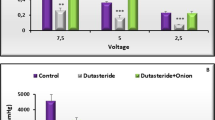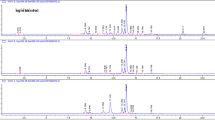Abstract
Background and objective: Benign prostatic hyperplasia (BPH) is a non-malignant enlargement of the prostate that results in obstructive lower urinary tract symptoms. Saw palmetto (Serenoa repens), the dwarf American palm (Arecaceae family), is commonly used to treat BPH. The Cuban royal palm (Roystonea regia) also belongs to the Arecaceae family, and 200–400mg of D-004, a lipid extract from its fruits, administered orally for 14 days has been shown to prevent testosterone- but not dihydrotestosterone-induced prostatic hyperplasia in rats. D-004 (125–250 μ/mL) added to preparations of rat vas deferens caused a marked, dose-dependent and significant inhibition of noradrenaline-induced smooth muscle contraction, a response mediated through α1-adrenoceptors, and was more effective in these respects than Saw palmetto. However, the in vivo effects of D-004 and Saw palmetto on the hypertensive response induced by noradrenaline were modest (albeit significant), and neither treatment affected resting blood pressure or heart rate in rats. The differential effects of D-004 in in vitro and in vivo models could be related to a differential affinity for adrenoceptor subtypes or to different bioavailabilities in vascular and urogenital targets. Phenylephrine injected into rodents induces prostatic hyperplasia with all the characteristic morphological changes of the condition but does not result in enlargement of the prostate. Therefore, this phenylephrine-induced change in rat prostate tissue is called atypical prostatic hyperplasia. It serves as an in vivo model of prostatic hyperplasia induced by stimulation of α1-adrenoceptors. The objective of this study was to determine whether D-004 can inhibit induction of atypical prostatic hyperplasia by phenylephrine in rats.
Methods: Rats were randomly distributed into five groups (ten rats/group). One group was a negative control and received oral vehicle only. The other four groups were injected subcutaneously with phenylephrine (2 mg/kg): of these groups, one was a positive control receiving the vehicle, and the other three groups were treated with D-004 or Saw palmetto (both 400 mg/kg) or tamsulosin 0.4 mg/kg. All active treatments were given orally for 28 days. After completion of treatment, rats were placed unrestrained in metabolic cages and micturition studies were performed. The rats were later killed and their prostates removed and weighed. Prostate samples were processed for histological study, with histological changes being assessed according to a scoring system. Bodyweight was measured at baseline and at weekly intervals.
Results: Histological examination of positive control rats revealed features of atypical prostatic hyperplasia, with piling-up, papillary and cribiform patterns and budding-out of epithelial cells. Micturition assessment revealed that phenylephrine significantly lowered both the total volume of urine in 1 hour and the volume per micturition; the latter was considered the main efficacy variable. D-004 and Saw palmetto extracts significantly prevented this reduction in volume per micturition by 70.5% and 68.6%, respectively, while tamsulosin totally abolished the reduction in micturition induced by phenylephrine (100% inhibition). Tamsulosin, D-004 and Saw palmetto significantly reduced the histological changes of atypical prostatic hyperplasia induced by phenylephrine by 73.1%, 61.2% and 50.0%, respectively.
Conclusions: Administration of D-004 resulted in marked and significant prevention of phenylephrine-induced impairment of micturition and histological changes in rat prostate. These findings indicate that, in vivo, D-004 effectively opposes these responses to phenylephrine, which are mediated through urogenital α1-adrenoceptors. In this respect, D-004 was moderately more effective than Saw palmetto, a phytotherapeutic standard used to treat BPH, but less effective than tamsulosin, a selective α1A-adrenoceptor antagonist.




Similar content being viewed by others
Notes
The use of trade names is for product identification purposes only and does not imply endorsement.
References
Madsen FA, Bruskewitz RC. Benign prostatic hyperplasia pathophysiology and pharmacological treatment. Curr Opin Nephrol Hypertens 1995; 4: 455–9
Bartsch G, Rittmaster RS, Klocker H. Dihydrotestosterone and the role of 5 alpha-reductase inhibitors in benign prostatic hyperplasia. Urologe A 2002; 41: 412–24
Carson C, Rittmaster R. The role of dihydrotestosterone in benign prostatic hyperplasia. Urology 2003; 61 Suppl. 1: 2–7
Deslypere JP, Young M, Wilson JD, et al. Testosterone and 5 α dihydrotestosterone interact differently with the androgen receptor to enhance transcription of the MMTV-CAT reporter gene. Mol Cell Endocrinol 1992; 88: 15–22
Boyle P, Gould AL, Roehrborn CG. Prostate volume predicts outcome of treatment of benign prostatic hyperplasia with finasteride: meta-analysis of randomized clinical trials. Urology 1996; 48: 398–405
Carson C, Rittmaster R. The role of dihydrotestosterone in benign prostatic hyperplasia. Urology 2003; 61 Suppl. 1: 2–7
Deslypere JP, Young M, Wilson JD, et al. Testosterone and 5 α dihydrotestosterone interact differently with the androgen receptor to enhance transcription of the MMTV-CAT reporter gene. Mol Cell Endocrinol 1992; 88: 15–22
Djavan B, Remzi M, Erne B, et al. The pathophysiology of benign prostatic hyperplasia. Drugs Today 2002; 38: 867–76
Barry MJ, Roehrborn CG. Benign prostatic hyperplasia. BMJ 2001; 323: 1042–6
Magee JC, Schofield GG. Neurotransmission through sympathetic ganglia of spontaneously hypertensive rats. Hypertension 1992; 20: 367–73
Furukawa S, Yamamoto O, Tamura T, et al. Influence of efonidipine hydrochloride, calcium antagonist on the epithelium of prostates in spontaneously hypertensive rats. J Toxicol Sci 1994; 19: 213–7
Pool JL. Role of the sympathetic nervous system in hypertension and benign prostatic hyperplasia. Br J Clin Pract Symp Suppl 1994; 74: 13–7
Golomb E, Kruglikova A, Dvir D, et al. Induction of atypical prostatic hyperplasia in rats by sympathomimetic stimulation. Prostate 1998; 34: 214–21
Baumgarten HG, Falck B, Holstein AF, et al. Adrenergic innervation of the human testis, epididymis, ductus deferens and prostate: a fluorescence microscopic and fluorimetric study. Z Zellforsch Mikrosk Anat 1968; 90: 81–95
Lepor H, Tang R, Meretyk S, et al. Alpha-1 adrenoceptor subtypes in the human prostate. J Urol 1993; 149: 640–2
Lepor H, Tang R, Meretyk S, et al. Binding and functional properties of alpha-1 adrenoceptors in different regions of the human prostate. J Urol 1993; 150: 253–6
Wang JM, McKenna KE, McVary KT, et al. Requirement of innervation for the maintenance of structural and functional integrity in the rat prostate. Biol Reprod 1991; 44: 1171–6
Martínez-Piñeiro L, Dahiya R, Nunes LL, et al. Pelvic plexus denervation in rats causes morphologic and functional changes of the prostate. J Urol 1993; 150: 215–8
Yamada S, Ashizawa N, Ushijima H, et al. Alpha-1 adrenoceptors in human prostate: characterization and alteration in benign prostatic hypertrophy. J Pharmacol Exp Ther 1987; 242: 326–32
Kawabe K, Ueno A, Takimoto Y, et al. Use of an α-blocker, YM-12617, in the treatment of benign prostatic hypertrophy: YM617 clinical study group. J Urol 1990; 144: 908–15
Jonlar M, Riehmann M, Bruskewitz RC. Benign prostatic hyperplasia: current pharmacological treatment. Drugs 1994; 47: 66–71
Yamagishi R, Akiyama K, Nakamura S, et al. Effect of KMD-3213, an α?1A- adrenoceptor-selective antagonist, on the contractions of rabbit prostate and rabbit and rat aorta. Eur J Pharmacol 1996; 315: 73–9
Marinese D, Patel R, Walden PD. Mechanistic investigation of the adrenergic induction of ventral prostatic hyperplasia in mice. Prostate 2003; 54: 230–7
Braekman J. The extract of Serenoa repens in the treatment of benign prostatic hyperplasia: a multicenter open study. Curr Ther Res 1994; 55: 776–86
Rhodes L, Primka RL, Berman C, et al. Comparison of finasteride (Proscar), a 5α?reductase inhibitor, and various commercial plant extracts on in vitro and in vivo 5 α- reductase inhibition. Prostate 1993; 22: 43–51
Bombardelli E, Morazzoni P. Serenoa repens (Bartram) JK Small. Fitoterapia 1997; LXVIII: 99–113
Plosker GL, Brogden RN. Serenoa repens (Permixon): a review of its pharmacological and therapeutic efficacy in benign prostatic hyperplasia. Drugs Aging 1996; 9: 379–95
Wilt TJ, Ishani A, Stark G, et al. Saw palmetto extracts for treatment of benign prostatic hyperplasia: a systematic review. JAMA 1998; 280: 1604–9
Gordon AE, Shaughnessy AF. Saw palmetto for prostate disorders. Am Fam Physician 2003; 67: 1281–3
Marks E. Effects of Saw palmetto herbal blend in men with symptomatic benign prostatic hyperplasia. J Urol 2000; 163: 1451–6
Carraro JC, Raynaud JP, Koch G, et al. Comparison of phytotherapy (Permixon) with finasteride in the treatment of benign prostatic hyperplasia: a randomized international study of 1098 patients. Prostate 1996; 29: 231–40
Goepel M, Hecker U, Krege S, et al. Saw palmetto extracts potently and non-competitively inhibit human alpha 1 adrenoceptors in vitro. Prostate 1999; 38: 208–15
Gutierrez M, Garcia de Boto MJ, Cantabrana B, et al. Mechanisms involved in the spasmolytic effect of extracts from Sabal serrulata fruit on smooth muscle. Gen Pharmacol 1996; 27: 171–6
Odenthal KP, Rauwald HW. Lipophilic extract from Sabal serrulata inhibits contractions in smooth muscle tissue. Aktuelle Urol 1996; 27: 152–7
Arruzazabala ML, Carbajal D, Mas R, et al. Preventive effects of D-004, a lipid extract from Cuban royal palm (Roystonea regia) fruits, on prostatic hyperplasia induced with testosterone on intact and castrated rodents. Drugs Exp Clin Res 2004; 30 (5–6): 227–33
Carbajal D, Arruzazabala ML, Mas R, et al. Effect of D-004, a lipid extract from Cuban royal palm fruit, on inhibiting prostatic hypertrophy induced with testosterone or dihydrotestosterone in a rat model: a randomized controlled study. Curr Ther Res 2004; 65: 505–14
Arruzazabala ML, Más R, Carbajal D, et al. Effect of D-004, a lipid extract from Cuban royal palm fruit, on in vitro and in vivo effects mediated by α adrenoceptors in rats. Drugs R D 2005; 6: 281–9
Constantinou CE. Influence of hormone treatment on prostate growth and micturition characteristics of the rat. Prostate 1996; 29: 30–5
Scolnik MD, Servadio C, Abramovici A. Comparative study of experimentally induced benign and atypical hyperplasia in the ventral prostate of different rat strains. J Androl 1994; 15: 287–97
Price DT, Schwinn DA, Lomasney JW, et al. Identification, quantification and localization of mRNA for three distinct alpha-1 adrenergic receptor subtypes in human prostate. J Urol 1993; 150: 546–50
Weinberg DH, Trivedi P, Tan CP, et al. Cloning, expression and characterization of human α adrenergic receptors α1A, α1B and α1C. Biochem Biophys Res Commun 1994; 201: 1296–302
Michel MC, Grubbel B, Taguchi K, et al. Drugs for treatment of benign prostatic hyperplasia: affinity comparison at cloned α1 adrenoceptor subtypes and in human prostate. J Auton Pharmacol 1996; 16: 21–8
Acknowledgements
This study was supported by a research grant from the West Havana Scientific Pole. The people involved in this study did not receive any special compensation for their participation in the study, and the only conflicts of interest of the authors are those related to participation in the research and development of D-004.
Author information
Authors and Affiliations
Corresponding author
Rights and permissions
About this article
Cite this article
Arruzazabala, M.L., Más, R., Molina, V. et al. Effect of D-004, a Lipid Extract from the Cuban Royal Palm Fruit, on Atypical Prostate Hyperplasia Induced by Phenylephrine in Rats. Drugs in R D 7, 233–241 (2006). https://doi.org/10.2165/00126839-200607040-00003
Published:
Issue Date:
DOI: https://doi.org/10.2165/00126839-200607040-00003




